VOLKSWAGEN TOUAREG 2012 Owners Manual
Manufacturer: VOLKSWAGEN, Model Year: 2012, Model line: TOUAREG, Model: VOLKSWAGEN TOUAREG 2012Pages: 684, PDF Size: 6.36 MB
Page 181 of 684
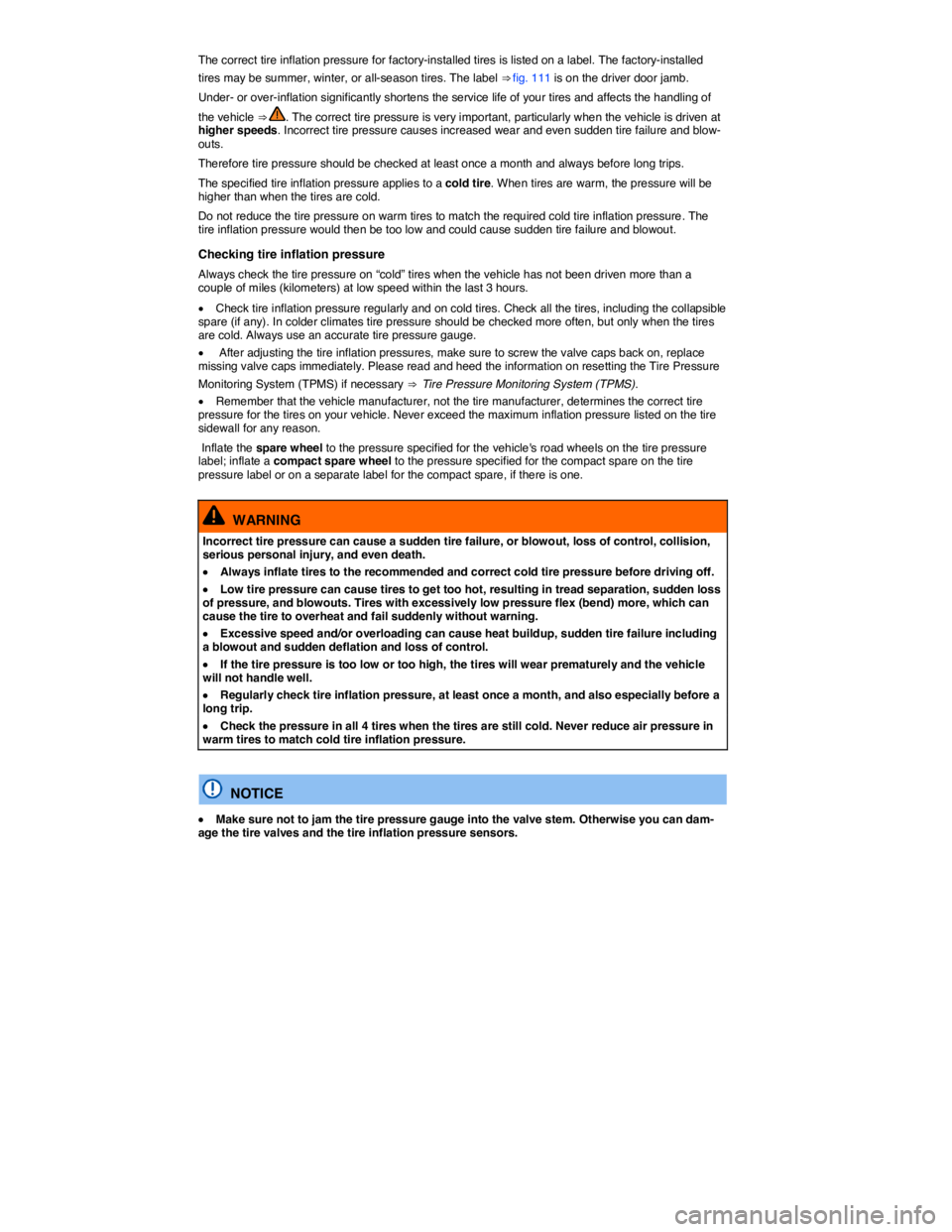
The correct tire inflation pressure for factory-installed tires is listed on a label. The factory-installed
tires may be summer, winter, or all-season tires. The label ⇒ fig. 111 is on the driver door jamb.
Under- or over-inflation significantly shortens the service life of your tires and affects the handling of
the vehicle ⇒ . The correct tire pressure is very important, particularly when the vehicle is driven at higher speeds. Incorrect tire pressure causes increased wear and even sudden tire failure and blow-outs.
Therefore tire pressure should be checked at least once a month and always before long trips.
The specified tire inflation pressure applies to a cold tire. When tires are warm, the pressure will be higher than when the tires are cold.
Do not reduce the tire pressure on warm tires to match the required cold tire inflation pressure. The tire inflation pressure would then be too low and could cause sudden tire failure and blowout.
Checking tire inflation pressure
Always check the tire pressure on “cold” tires when the vehicle has not been driven more than a couple of miles (kilometers) at low speed within the last 3 hours.
�x Check tire inflation pressure regularly and on cold tires. Check all the tires, including the collapsible spare (if any). In colder climates tire pressure should be checked more often, but only when the tires are cold. Always use an accurate tire pressure gauge.
�x After adjusting the tire inflation pressures, make sure to screw the valve caps back on, replace missing valve caps immediately. Please read and heed the information on resetting the Tire Pressure
Monitoring System (TPMS) if necessary ⇒ Tire Pressure Monitoring System (TPMS).
�x Remember that the vehicle manufacturer, not the tire manufacturer, determines the correct tire pressure for the tires on your vehicle. Never exceed the maximum inflation pressure listed on the tire sidewall for any reason.
Inflate the spare wheel to the pressure specified for the vehicle's road wheels on the tire pressure label; inflate a compact spare wheel to the pressure specified for the compact spare on the tire pressure label or on a separate label for the compact spare, if there is one.
WARNING
Incorrect tire pressure can cause a sudden tire failure, or blowout, loss of control, collision, serious personal injury, and even death.
�x Always inflate tires to the recommended and correct cold tire pressure before driving off.
�x Low tire pressure can cause tires to get too hot, resulting in tread separation, sudden loss of pressure, and blowouts. Tires with excessively low pressure flex (bend) more, which can cause the tire to overheat and fail suddenly without warning.
�x Excessive speed and/or overloading can cause heat buildup, sudden tire failure including a blowout and sudden deflation and loss of control.
�x If the tire pressure is too low or too high, the tires will wear prematurely and the vehicle will not handle well.
�x Regularly check tire inflation pressure, at least once a month, and also especially before a long trip.
�x Check the pressure in all 4 tires when the tires are still cold. Never reduce air pressure in warm tires to match cold tire inflation pressure.
NOTICE
�x Make sure not to jam the tire pressure gauge into the valve stem. Otherwise you can dam-age the tire valves and the tire inflation pressure sensors.
Page 182 of 684

�x Driving without valve caps, with the wrong valve caps, or with valve caps that are not properly screwed on can damage the tire valves and the sensors on the Tire Pressure Monitor-ing System (TPMS). To help prevent damage, always use valve stem caps like those originally installed at the factory. The caps must be screwed on tightly. Do not use metal valve caps or “comfort” valve stem caps.
Underinflation increases fuel consumption.
Pressures measured with a gauge when inflating the tires may be different from the pressures read by the tire pressure sensors. The electronic TPMS is more accurate.
When the TPMS warns that the pressure in at least one tire is too low, check the tire pressure in all 4 tires with an accurate tire pressure gauge. Low tire pressure usually cannot be spotted by looking
at the tire. This is especially true for low-profile tires. When checking the tire pressures, refer to ⇒ Tire Pressure Monitoring System (TPMS).
Tire inflation pressure in cold tires
�
Page 183 of 684
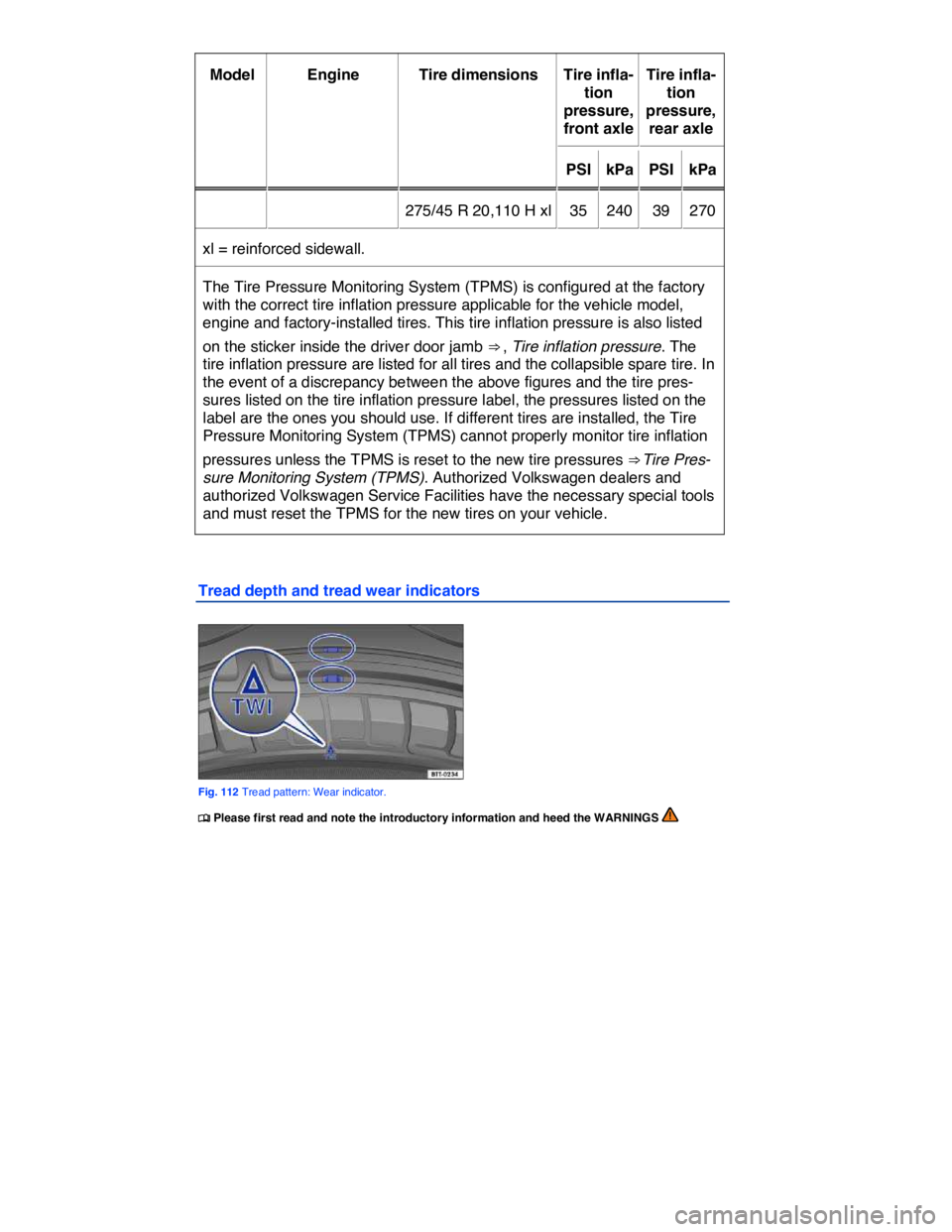
Model Engine Tire dimensions Tire infla-
tion
pressure,
front axle
Tire infla-
tion
pressure,
rear axle
PSI kPa PSI kPa
275/45 R 20,110 H xl 35 240 39 270
xl = reinforced sidewall.
The Tire Pressure Monitoring System (TPMS) is configured at the factory
with the correct tire inflation pressure applicable for the vehicle model,
engine and factory-installed tires. This tire inflation pressure is also listed
on the sticker inside the driver door jamb ⇒ , Tire inflation pressure. The
tire inflation pressure are listed for all tires and the collapsible spare tire. In
the event of a discrepancy between the above figures and the tire pres-
sures listed on the tire inflation pressure label, the pressures listed on the
label are the ones you should use. If different tires are installed, the Tire
Pressure Monitoring System (TPMS) cannot properly monitor tire inflation
pressures unless the TPMS is reset to the new tire pressures ⇒Tire Pres-
sure Monitoring System (TPMS). Authorized Volkswagen dealers and
authorized Volkswagen Service Facilities have the necessary special tools
and must reset the TPMS for the new tires on your vehicle.
Tread depth and tread wear indicators
Fig. 112 Tread pattern: Wear indicator.
�
Page 184 of 684

Tread depth
Most driving situations require as much tread depth as possible and similar tread depth for the tires on the front and rear wheels. This is especially true when driving in winter weather, at low temperatures
and under wet conditions ⇒ .
In most countries the legally permissible minimum tread depth is 06 in (1/16 in; 1.6 mm), as measured in tread grooves next to the wear indicators. Please be sure to obey country-specific legal require-ments.
Winter tires are no longer suitable for winter operation once the tread pattern is worn down to a depth of 3/16 in (4.8 mm).
The tread depth of new tires can differ between tire models and manufacturers because of the differ-ent design features and tread patterns.
Tread wear indicator (TWI) in the tire
The 1/16 in (1.6 mm) high wear indicators are molded into the bottom of the tread grooves of the
original tires running across the treads ⇒ fig. 112. Several wear indicators are evenly spaced around the tire. Markings on the sides of the tires (for example “TWI” or symbols) show the position of the wear indicators.
Wear indicators show when the tires are worn down. The tires must be replaced no later than when the tread pattern is worn down to the wear indicators.
WARNING
Worn tires are dangerous and can cause loss of vehicle control including serious personal injuries.
�x Never drive a vehicle when the tread on any tire is worn down to the wear indicators, re-place them sooner.
�x Worn tires do not grip the road properly, especially on wet roads, increasing your risk of “hydroplaning” and loss of control.
�x Worn tires reduce the ability of your vehicle to handle well in normal and difficult driving situations and increase braking distances and the risk of skidding.
Tire wear and damage
�
Page 185 of 684
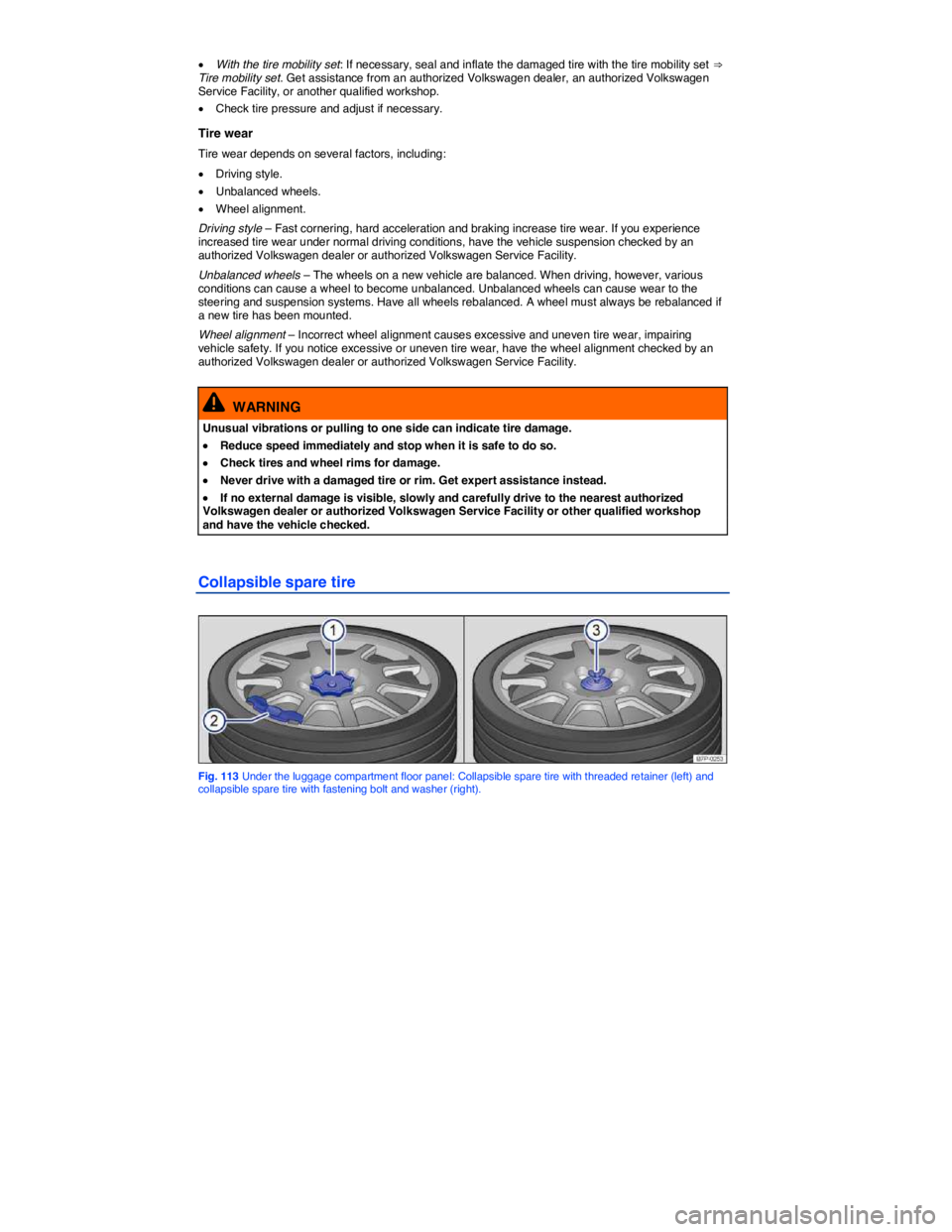
�x With the tire mobility set: If necessary, seal and inflate the damaged tire with the tire mobility set ⇒ Tire mobility set. Get assistance from an authorized Volkswagen dealer, an authorized Volkswagen Service Facility, or another qualified workshop.
�x Check tire pressure and adjust if necessary.
Tire wear
Tire wear depends on several factors, including:
�x Driving style.
�x Unbalanced wheels.
�x Wheel alignment.
Driving style – Fast cornering, hard acceleration and braking increase tire wear. If you experience increased tire wear under normal driving conditions, have the vehicle suspension checked by an authorized Volkswagen dealer or authorized Volkswagen Service Facility.
Unbalanced wheels – The wheels on a new vehicle are balanced. When driving, however, various conditions can cause a wheel to become unbalanced. Unbalanced wheels can cause wear to the steering and suspension systems. Have all wheels rebalanced. A wheel must always be rebalanced if a new tire has been mounted.
Wheel alignment – Incorrect wheel alignment causes excessive and uneven tire wear, impairing vehicle safety. If you notice excessive or uneven tire wear, have the wheel alignment checked by an authorized Volkswagen dealer or authorized Volkswagen Service Facility.
WARNING
Unusual vibrations or pulling to one side can indicate tire damage.
�x Reduce speed immediately and stop when it is safe to do so.
�x Check tires and wheel rims for damage.
�x Never drive with a damaged tire or rim. Get expert assistance instead.
�x If no external damage is visible, slowly and carefully drive to the nearest authorized Volkswagen dealer or authorized Volkswagen Service Facility or other qualified workshop and have the vehicle checked.
Collapsible spare tire
Fig. 113 Under the luggage compartment floor panel: Collapsible spare tire with threaded retainer (left) and collapsible spare tire with fastening bolt and washer (right).
Page 186 of 684
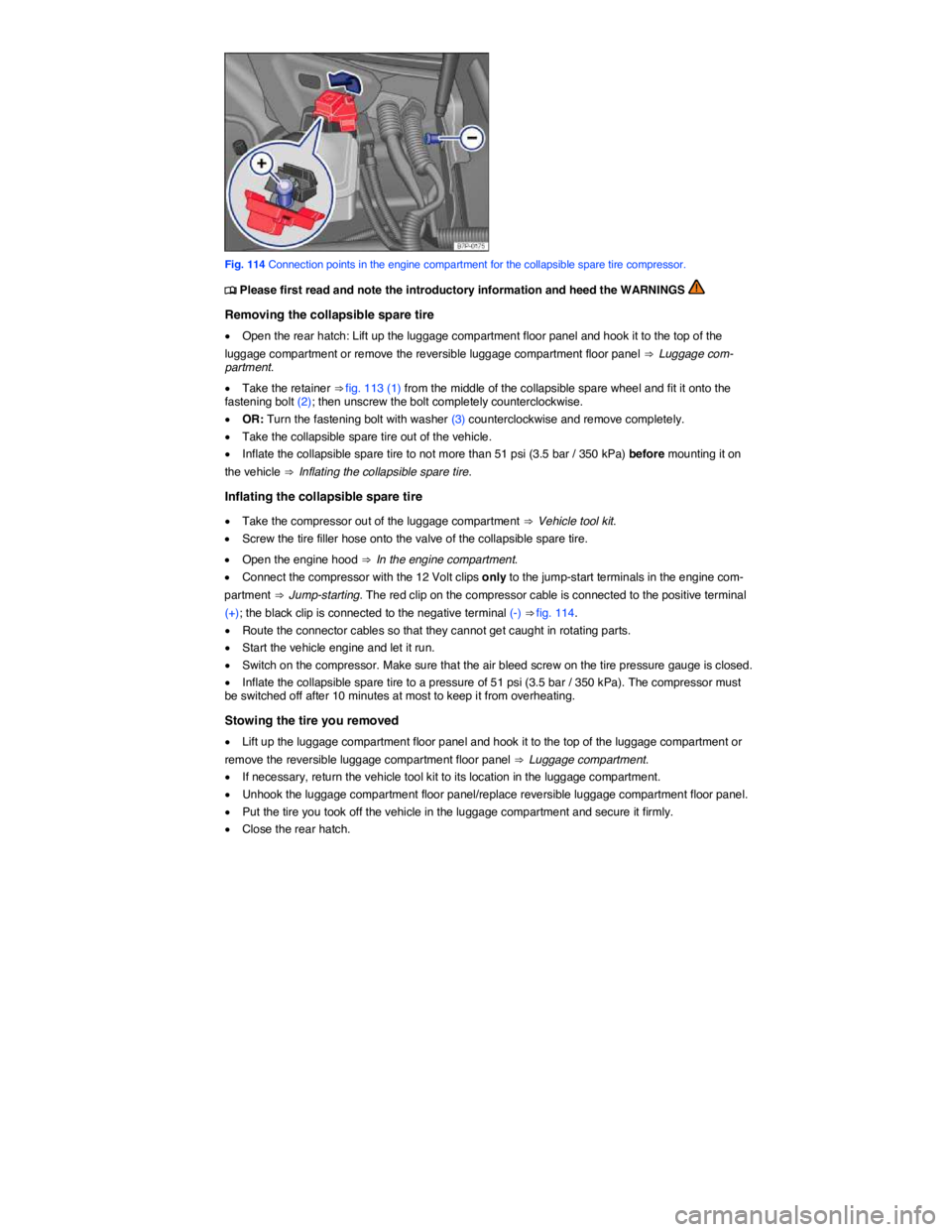
Fig. 114 Connection points in the engine compartment for the collapsible spare tire compressor.
�
Page 187 of 684

Driving with the collapsible spare tire
The collapsible spare tire is different in design from the road tires and must be used only in the event
of a flat tire, only for a brief time, and only when driving with extra caution ⇒ .
Replace it with a tire matching the others on your vehicle as soon as possible.
Please heed the following:
�x Do not drive faster than 50 mph (80 km/h)!
�x Avoid full-throttle acceleration, hard braking and fast cornering!
�x Do not use snow chains on the collapsible spare tire.
�x After installing the collapsible spare tire, check the tire pressure as soon as possible ⇒ Checking tire inflation pressure.
Reusing the collapsible spare tire
The collapsible spare tire can be reused as long as it is not damaged and not worn down to the tread wear indicators.
It takes several hours for the collapsible spare tire to return to its collapsed form after you let the air out of it. Once this has happened, you can put it back in the spare tire well and secure it.
�x Let the air out of the tire by unscrewing the valve core.
�x Screw the valve core back in once the air has been released.
�x Wait several hours before putting the collapsible spare tire back in the spare tire well.
�x Once the time is up, open the rear hatch. Lift up the luggage compartment floor panel and hook it
to the top of the luggage compartment or remove the reversible luggage compartment floor panel ⇒ Luggage compartment.
�x Place the collapsible spare tire in the spare tire well and secure it with the fastening bolt (⇒ fig. 113 (2) or (3)).
�x Fit the retainer (1) back into the middle of the collapsible spare tire ⇒ fig. 113.
�x Unhook the luggage compartment floor panel/replace reversible luggage compartment floor panel.
�x Close the rear hatch.
Page 188 of 684

WARNING
Improper use of a collapsible spare tire can cause loss of vehicle control, a crash or other accident, and serious personal injury.
�x Never use a collapsible spare tire if it is damaged or worn down to the wear indicators.
�x The collapsible spare tire is identified by a sticker and the words “50 mph” or “80 km/h”. This is the maximum permissible speed when driving with this tire.
�x Never drive faster than 50 mph (80 km/h) with a collapsible spare tire. Avoid full-throttle acceleration, heavy braking, and fast cornering!
�x Never drive more than 125 miles (200 km) if a compact spare wheel is installed on the front axle (drive axle).
�x Replace the collapsible spare tire with a normal wheel as soon as possible. Collapsible spare tires are designed for brief use only.
�x Regularly check U.S. DOT tire identification number (TIN) to determine the age of the col-
lapsible spare tire ⇒ Tire labeling. Tires age even if they are not being used and can fail sud-denly, especially at higher speeds.
�x Tires that are more than 6 years old can only be used in an emergency and then with spe-cial care and at lower speeds.
�x The collapsible spare tire must always be secured with the wheel bolts provided by the factory.
�x Never drive using more than one collapsible spare tire.
�x After installing the collapsible spare tire, the tire pressure must be checked as soon as
possible ⇒ Tire inflation pressure.
�x Snow chains cannot be used on the collapsible spare tire. If you need the snow chains, but one of the front tires is flat, you have to mount the collapsible spare tire on the rear axle. The tire taken off the rear axle can then be used to replace the flat front tire. Be sure to main-tain the tire's direction of rotation. Install the snow chains on the full-sized road wheel.
If possible, fasten the collapsible spare tire or the wheel you took off the vehicle securely in the luggage compartment. On vehicles equipped with a tire mobility set, the tire you took off the vehicle cannot be secured.
Page 189 of 684
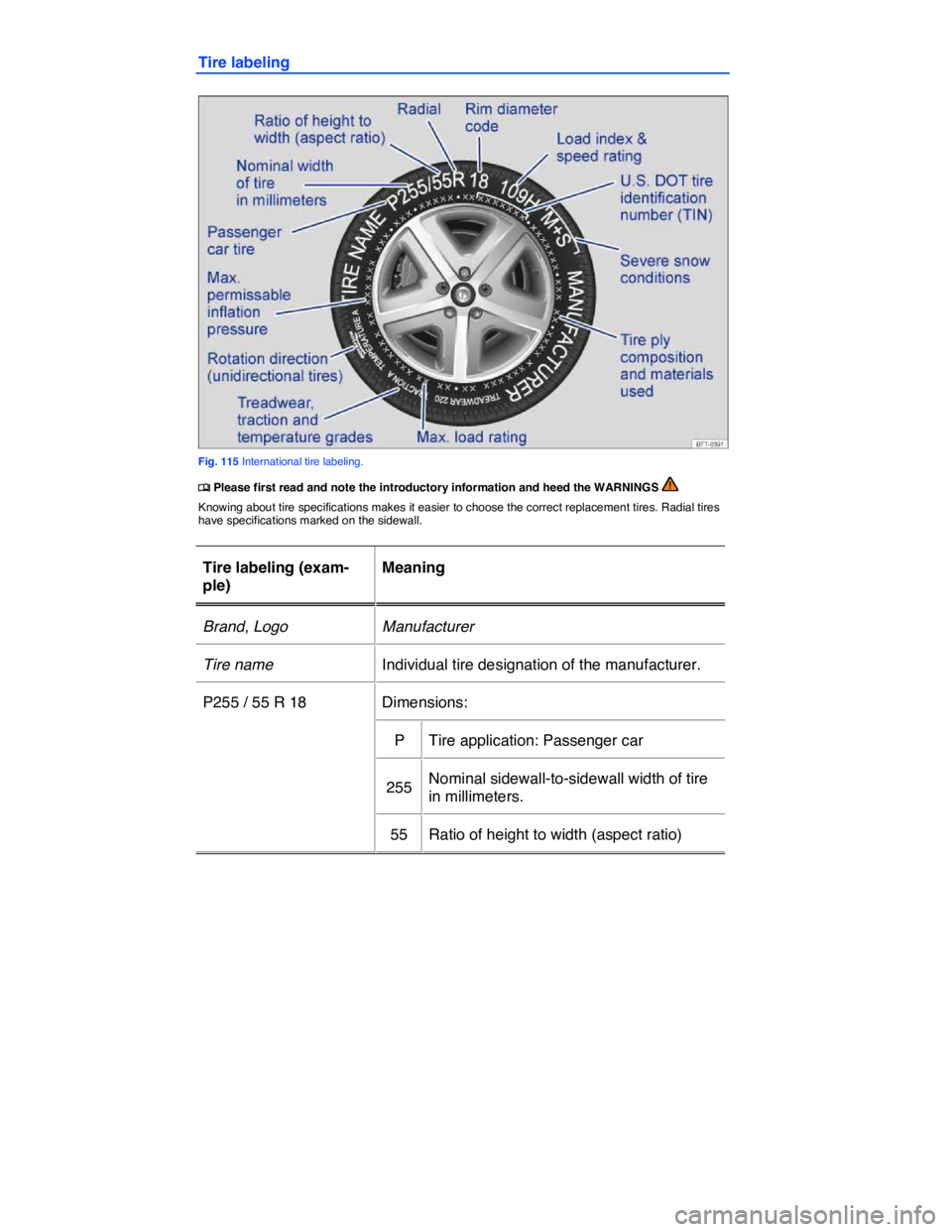
Tire labeling
Fig. 115 International tire labeling.
�
Page 190 of 684

Tire labeling (exam-
ple)
Meaning
R Tire belt design letter code for radial.
18 Rim diameter (in inches)
109 H Load rating code and speed rating code ⇒ Tire
labeling.
XL Indicates “reinforced” tire (heavy-duty)
M+S or M/S Indicates Mud and Snow capability (also M/S)
RADIAL TUBELESS Tubeless radial tire.
E4 … Labeling according to international regulations
(E) including number of the approving country.
The multi-digit approval number is listed next.
DOT BT RA TY5 1709 Tire identification number (TIN3 - In some cases
the manufacturing date is only on one side of the
tire:
DOT The tire complies with the requirements of
the United States Department of Trans-
portation, responsible for issuing safety
standards.
BT Identification letter of the manufacturing
site.
RA Manufacturer information regarding tire
dimensions.
TY5 Tire characteristics provided by the
manufacturer.
1709 Manufacturing date: 17th week in 2009.
3 TIN represents the serial number of the tire.